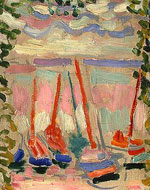
This exhibition is no longer on view at the National Gallery. Please follow the links below for related online resources or visit our current exhibitions schedule.
 The National Gallery of Art will bring together its collection of fauve paintings in an exhibition to commemorate the one hundredth anniversary of the naming of this movement in French art. In the fall of 1905, critic Louis Vauxcelles first coined the epithet fauve, or "wild beast," to characterize what appeared to be an explosion of color in the work of a loosely knit group of young painters exhibiting at the Salon d'automne in Paris. Between roughly 1904 and 1907, Henri Matisse, André Derain, Georges Braque, Maurice de Vlaminck, and others brought a newly liberated colorism into cityscape and landscape paintings. Working with an intense, unmodulated application of pure color and the bold strokes of a loaded brush, these artists adapted the advances of postimpressionism, creating a presumably more impetuous or "anarchic" manner.
The National Gallery of Art will bring together its collection of fauve paintings in an exhibition to commemorate the one hundredth anniversary of the naming of this movement in French art. In the fall of 1905, critic Louis Vauxcelles first coined the epithet fauve, or "wild beast," to characterize what appeared to be an explosion of color in the work of a loosely knit group of young painters exhibiting at the Salon d'automne in Paris. Between roughly 1904 and 1907, Henri Matisse, André Derain, Georges Braque, Maurice de Vlaminck, and others brought a newly liberated colorism into cityscape and landscape paintings. Working with an intense, unmodulated application of pure color and the bold strokes of a loaded brush, these artists adapted the advances of postimpressionism, creating a presumably more impetuous or "anarchic" manner.
The National Gallery of Art possesses a splendid collection of fauve paintings. Highlights include Braque's The Port of La Ciotat (1907); Vlaminck's Tugboat on the Seine, Chatou (1906); and Derain's Charing Cross Bridge, London (1906). The crown jewel of the exhibition is Matisse's small but riveting Open Window, Collioure (1905), a bequest of Mr. and Mrs. John Hay Whitney. It is the central icon of the fauve movement and one of Matisse's acknowledged early masterpieces.


